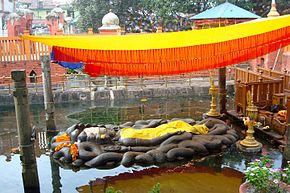Budhanilkantha
Coordinates: 27 ° 46 ′ 41 ″ N , 85 ° 21 ′ 44 ″ E
Budhanilkantha is a temple complex dedicated to Vishnu in his form as Jalashayana Narayan at the foot of Shivapuri north of Kathmandu in Nepal .
location
The temple complex of Budhanilkantha is located in the center of the village of Narayanthan around 12 km (driving distance) north of the city center of Kathmandu. The temple, located at an altitude of around 1450 meters, is dominated by the peaks of Shivapuri, which forms the northern edge of the Kathmandu Valley .
Naming
The name Budhanilkantha is composed of budha ('hidden in the mud') and nilkantha ('blue neck ').
Two legends led to the strange naming - while plowing his field, a farmer found a lost statue, which began to bleed after being touched by the plow. The legend of the "blue neck" is associated with Vishnu, but mostly with Shiva - the god sacrificed himself and drank the poison of the milk ocean , which colored his throat blue. In order to alleviate the burning sensation caused by this, he threw himself into the lake Gosainkund , which is supposed to feed the basin in Budhanilkantha.
history
The - exceptionally well preserved - cult image that can be assigned to the Licchavi period consists of a block of black basalt, which does not occur in the northern Kathmandu valley and was probably brought here by adherents of Vishnuism . It was first mentioned in 642, although it is possible that it was created as early as the 5th century. It is considered to be one of the main shrines of the Licchavi Empire in the Kathmandu Valley , ruled from Hadigaon ; other temples from this period can be found in Balaju and in the garden of the old royal palace of Kathmandu.
With the appearance of the early Malla dynasty the importance of the hitherto dominant Vishnuism against the started Shaivism losing in importance - the importance of the temple disappeared, especially since it was forbidden to the rulers because of the prophecy of immediate death in consideration of the idol to visit Budhanilkantha .
In particular, the construction of a Hare Krishna temple in 1970 and a school complex with boarding school in 1972 have had a significant impact on the surroundings of the formerly very remote temple complex of Budhanilkantha, numerous new buildings were built in the last decades of the 20th century, including a concrete fence around around the water basin, which hinders the previously unobstructed view of this and the cult image. In addition, numerous trees were felled in and around the temple complex.
Temple complex
The center of the facility is the approximately 13-meter-long water tank depicting the primeval ocean with the cult image, which has been surrounded by a less advantageous concrete fence since the renovation work. In its vicinity there are some smaller temples and shrines, mostly of more recent date, a Shiva lingam and some benches. The temple district is surrounded by a wall with four gates, the formerly rich population of pipal trees has been severely thinned.
Cult image
The cult image, which is about 5 meters in size, shows Vishnu as Jalashayana Narayan resting on the multi-twisted body of the world serpent Ananta , which drifts on the primordial ocean and guards the sleep of the god with its eleven heads. The posture of the statue of Vishnu with loosely bent legs and the relaxed expression of the face justify the unique charisma of the cult image. The four hands of the god show his attributes discus, lotus, conch shell and club ( chakra , padma , shankha , gada ); from his navel springs a lotus which will give birth to Brahma - the creator of the world.
Access to the statue is only permitted to Hindus at the foot end, the idol itself can only be entered by Brahmins . As part of a puja, which takes place daily from 9:00 a.m., they wash the face and feet of the statue first with water and later with a mixture of ghee , milk, yogurt, honey and sugar. Finally, the flowers presented as offerings by the pilgrims are draped around the head of Vishnu.
Festivals
The pilgrimage to Budhanilkantha reaches its climax during the Haribodhini Ekadasi (also Baikuntha-Chaturdasi ), the eleventh day of the month of Kartik (October / November), on which, according to a legend, Vishnu's four-month absence during the monsoons ends. During the next four days, thousands crowd the grounds of the temple complex of Budhanilkantha.
See also
literature
- Around Kathmandu Valley, Nepal Map Publisher Pvt. Ltd., Kathmandu 2009.
- John Sanday: Collins illustrated guide to the Kathmandu valley. The Guidebook Company, Landon 1989, ISBN 0-00215-215-0 .
- Baedeker Allianz travel guide Nepal. 2nd Edition. Verlag Karl Baedeker, Ostfildern 1999, ISBN 3-89525-012-0 .
- Rainer Krack: Nepal - Kathmandu Valley. Reise Know-How Verlag Rump, Bielefeld 2009, ISBN 978-3-8317-1793-4 .
- Joseph Bindloss, Trent Holden, Bradley Mayhew: Nepal. 8th edition. Lonely Planet Publications, Melbourne 2009, ISBN 978-1-74104-832-2 .
Web links
- Shesha Wikipedia (engl.)
- Budhanilkantha - Photos 1
- Budhanilkantha - Photos 2

